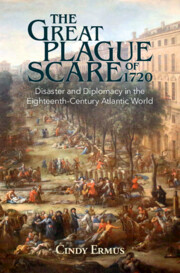100 results
7 - A Perfect Storm
-
- Book:
- Race, Taste and the Grape
- Published online:
- 16 March 2024
- Print publication:
- 28 March 2024, pp 224-249
-
- Chapter
- Export citation

Race, Taste and the Grape
- South African Wine from a Global Perspective
-
- Published online:
- 16 March 2024
- Print publication:
- 28 March 2024
COVID-19 passenger screening to reduce travel risk and translocation of disease
-
- Journal:
- Epidemiology & Infection / Volume 152 / 2024
- Published online by Cambridge University Press:
- 08 February 2024, e36
-
- Article
-
- You have access
- Open access
- HTML
- Export citation
Chapter 32 - Quarantine, Lockdown, and Isolation in the COVID-19 Pandemic
- from Section 4 - Responses to Meet the Mental Health Needs of People Affected by Emergencies, Major Incidents, and Pandemics
-
-
- Book:
- Major Incidents, Pandemics and Mental Health
- Published online:
- 11 January 2024
- Print publication:
- 01 February 2024, pp 241-246
-
- Chapter
- Export citation
Chapter 33 - Reflections on Managing Infectious Diseases in Mental Health Units
- from Section 4 - Responses to Meet the Mental Health Needs of People Affected by Emergencies, Major Incidents, and Pandemics
-
-
- Book:
- Major Incidents, Pandemics and Mental Health
- Published online:
- 11 January 2024
- Print publication:
- 01 February 2024, pp 247-251
-
- Chapter
- Export citation
Evaluation of phase-adjusted interventions for COVID-19 using an improved SEIR model
-
- Journal:
- Epidemiology & Infection / Volume 152 / 2024
- Published online by Cambridge University Press:
- 13 November 2023, e9
-
- Article
-
- You have access
- Open access
- HTML
- Export citation
13 - Romantic Relationships during a Global Pandemic
-
-
- Book:
- The Sociocultural Context of Romantic Relationships
- Published online:
- 19 October 2023
- Print publication:
- 02 November 2023, pp 247-272
-
- Chapter
- Export citation
Network analysis of physical activity and depressive and affective symptoms during COVID-19 home confinement
-
- Journal:
- Cambridge Prisms: Global Mental Health / Volume 10 / 2023
- Published online by Cambridge University Press:
- 21 September 2023, e63
-
- Article
-
- You have access
- Open access
- HTML
- Export citation
6 - Race, Gender, and Control
-
- Book:
- When Disease Came to This Country
- Published online:
- 20 July 2023
- Print publication:
- 10 August 2023, pp 154-189
-
- Chapter
- Export citation
4 - The Spanish Plague That Never Was
-
- Book:
- The Great Plague Scare of 1720
- Published online:
- 11 November 2022
- Print publication:
- 01 December 2022, pp 141-176
-
- Chapter
- Export citation
2 - “L’état le Plus Exposé”
-
- Book:
- The Great Plague Scare of 1720
- Published online:
- 11 November 2022
- Print publication:
- 01 December 2022, pp 65-102
-
- Chapter
- Export citation
Epilogue
-
- Book:
- The Great Plague Scare of 1720
- Published online:
- 11 November 2022
- Print publication:
- 01 December 2022, pp 214-219
-
- Chapter
- Export citation
Introduction
-
- Book:
- The Great Plague Scare of 1720
- Published online:
- 11 November 2022
- Print publication:
- 01 December 2022, pp 1-12
-
- Chapter
- Export citation
3 - “A Scheme so Barbarous and so Destructive”
-
- Book:
- The Great Plague Scare of 1720
- Published online:
- 11 November 2022
- Print publication:
- 01 December 2022, pp 103-140
-
- Chapter
- Export citation

The Great Plague Scare of 1720
- Disaster and Diplomacy in the Eighteenth-Century Atlantic World
-
- Published online:
- 11 November 2022
- Print publication:
- 01 December 2022
Trust, Democracy, and Hygiene Theatre: Taiwan’s Evasion of the Pandemic
-
- Journal:
- Asian Journal of Law and Society / Volume 10 / Issue 1 / February 2023
- Published online by Cambridge University Press:
- 23 September 2022, pp. 46-56
-
- Article
- Export citation
All that was missing from the students of the University of Patras and the return to a new daily life after quarantine
-
- Journal:
- European Psychiatry / Volume 65 / Issue S1 / June 2022
- Published online by Cambridge University Press:
- 01 September 2022, pp. S527-S528
-
- Article
-
- You have access
- Open access
- Export citation
Eating habits during quarantine: Investigating the role of emotions and loneliness in a sample of adults in Greece
-
- Journal:
- European Psychiatry / Volume 65 / Issue S1 / June 2022
- Published online by Cambridge University Press:
- 01 September 2022, p. S534
-
- Article
-
- You have access
- Open access
- Export citation
An increase in somatization in pandemic time in association with lexical characterictic of statements about pandemic
-
- Journal:
- European Psychiatry / Volume 65 / Issue S1 / June 2022
- Published online by Cambridge University Press:
- 01 September 2022, p. S486
-
- Article
-
- You have access
- Open access
- Export citation
Mental Health Impacts of Quarantine: Insights from the COVID-19 International Border Surveillance Study in Toronto, Canada
-
- Journal:
- European Psychiatry / Volume 65 / Issue S1 / June 2022
- Published online by Cambridge University Press:
- 01 September 2022, p. S135
-
- Article
-
- You have access
- Open access
- Export citation


